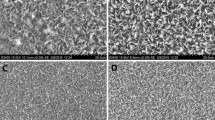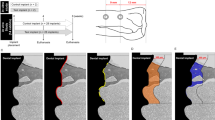Abstract
This study investigates the long-term biocompatibility of 0.5 % zinc-containing hydroxyapatite compared with hydroxyapatite. Spheres (425 < ∅ < 550) of both materials were produced by extrusion of ceramic slurry in calcium chloride and characterized by FTIR, XRD, XRF and SEM. Fifteen White New Zealand rabbits were submitted to general anesthesia, and an perforation (2 mm), was made in each tibia, one for zinc-containing hydroxyapatite sphere implantation and one for hydroxyapatite sphere implantation. After 26, 52 and 78 weeks, the animals were euthanized, and the fragment containing the biomaterial was harvested. A 30–50 μm section was obtained for histological analysis in bright field and polarized light. SEM images revealed similar morphologies between the tested biomaterials. Histological analysis showed that there was no difference between the test groups. The morphometric analysis, however, indicates that there was a greater absorption. The materials are biocompatible, promote osteogenesis and that the zinc-containing hydroxyapatite microspheres were absorbed more quickly.










Similar content being viewed by others
References
Hing KA, Wilson LF, Buckland T. Comparative performance of three ceramic bone graft substitutes. Spine J. 2007;7:475–90.
Torrent-Burgues J, Rodriguez-Clemente R. Hydroxyapatite precipitation in a semibatch process. Cryst Res Technol. 2001;36:1075–82.
Webster TJ, Ergun C, Doremus RH, Bizios R. Hydroxyapatite with substituted magnesium, zinc, cadmium, and yttrium II: mechanisms of osteoblast adhesion. J Biomed Mater Res A. 2002;59:312–7.
Webster TJ, Massa-Schluter EA, Smith JL, Slamovich EB. Osteoblast response to hydroxyapatite doped with divalent and trivalent cations. Biomaterials. 2004;25:2111–21.
Matsunaga K, Murata H, Mizoguchi T, Nakahira A. Mechanism of incorporation of zinc into hydroxyapatite. Acta Biomater. 2009;6:2289–93.
Salgueiro MJ, Zubillaga M, Lysionek A, Sarabia MI, Caro R, De Paoli T, Hager A, Weill R, Boccio J. Zinc status and immune system relationship: a review. Biol Trace Elem Res. 2000;76:193–205.
Ito A, Ojima K, Naito H, Ichinose N, Tateisci T. Preparation, solubility, and cytocompatibility of zinc-releasing calcium phosphate ceramics. J Biomed Mater Res. 2000;50:178–83.
Ito A, Kawamura H, Otsuka M, Ikeuchi M, Ohgushi H, Ishikawa K, Onuma K, Kanzaki N, Sogo Y, Ichinose N. Zinc-releasing calcium phosphate for stimulating bone formation. Mater Sci Eng, C. 2002;22:21–5.
Ito A, Otsuka M, Kawamura H, Ikeuchi M, Ohgushi H, Sogo Y, Ichinose N. Zinc-containing tricalcium phosphate and related materials for promoting bone formation. Curr Appl Phys. 2005;5:402–6.
Moonga BS, Dempster DW. Zinc is a potent inhibitor of osteoclastic bone resorption in vitro. J Bone Miner Res. 1995;10:453–7.
Landi E, Logroscino G, Proietti L, Tampieri A, Sandri M, Sprio S. Biomimetic Mg-substituted hydroxyapatite: from synthesis to in vivo behavior. J Mater Sci-Mater M. 2008;19:239–47.
Storrie H, Stupp SI. Cellular response to zinc-containing organoapatite: An in vitro study of proliferation, alkaline phosphatase activity and biomineralization. Biomaterials. 2005;26:5492–9.
Fernandes GVO, Calasans-Maia MD, Mitri FF, Bernardo VG, Rossi A, Almeida GDS, Granjeiro JM. Histomorphometric Analysis of Bone Repair in Critical Size Defect in Rats Calvaria Treated with Hydroxyapatite and Zinc-Containing Hydroxyapatite 5%. Key Eng Mater. 2009;396–398:15–8.
Conz MB, Granjeiro JM, Soares Gde A. Hydroxyapatite crystallinity does not affect the repair of critical size bone defects. J Appl Oral Sci. 2011;19:337–42.
Cestari TM, Granjeiro JM, de Assis GF, Garlet GP, Taga R. Bone repair and augmentation using block of sintered bovine-derived anorganic bone graft in cranial bone defect model. Clin Oral Implants Res. 2009;20:340–50.
Accorsi-Mendonça T, Conz MB, Barros TC, de Sena LA. Soares Gde A, Granjeiro JM. Physicochemical characterization of two deproteinized bovine xenografts. Braz Oral Res. 2008;22:5–10.
Barrere F, Van Blitterswijk CA, Groot KD. Bone regeneration: molecular and cellular interactions with calcium phosphate ceramics. Int J Nanomed. 2006;1:317–32.
de Lima IR, Alves GG, Soriano CA, Campaneli AP, Gasparoto TH, Ramos ES Jr, de Sena LÁ, Rossi AM, Granjeiro JM. Understanding the impact of divalent cation substitution on hydroxyapatite: an in vitro multiparametric study on biocompatibility. J Biomed Mater Res A. 2011;98:351–8.
de Souza CA, Colombo AP, Souto RM, Silva-Boghossian CM, Granjeiro JM, Alves GG, Rossi AM, Rocha-Leão MH. Adsorption of chlorhexidine on synthetic hydroxyapatite and in vitro biological activity. Colloids Surf B Biointerfaces. 2011;87:310–8.
Bazin D, Carpentier X, Traxer O, Thiaudiere D, Somogvi A, Reguer S. Very first tests on soleil regarding the Zn environment in pathological calcifications made of apatite determined by X-ray absorption spectroscopy. J Synchrotron Radiat. 2008;15:506–9.
Tang Y, Chappell HF, Dove MT, Reeder RJ, Lee YJ. Zinc incorporation into hydroxylapatite. Biomaterials. 2009;30:2864–72.
Costa AM, Soares GA, Calixto R, Rossi AM. Preparation and properties of zinc containing biphasic calcium phosphate bioceramics. Key Eng Mater. 2004;254–256:119–22.
Kawamura H, Ito A, Muramatsu T, Miyakawa S, Ochiai N, Tateishi T. Long term implantation of zinc-releasing calcium phosphate ceramics in rabbit femora. J Biomed Mater Res A. 2003;65:468–74.
Calasans-Maia MD, Rossi AM, Dias EP, Santos SRA, Ascoli FO, Granjeiro JM. Stimulatory effect on osseous repair of zinc-substituted hydroxyapatite: Histological study in rabbit’s tibia. Key Eng Mater. 2008;361–363:1269–72.
Kawachi EY, Bertran CA, Reis R, Alves OL. Biocerâmicas: tendências e perspectivas de uma área interdisciplinar. Quim Nova. 2000;23:518–22.
Riminucci M, Bianco P. Building bone tissue: matrices and scaffolds in physiology and biotechnology. Braz J Med Biol Res. 2003;36:1027–36.
Li X, Sogo Y, Ito A, Mutsuzaki H, Ochial N, Kobayashi T, Nakamura S, Yamashita K, Legeros RZ. The optimum zinc content in set calcium phosphate cement for promoting bone formation in vivo. Mater Sci Eng, C. 2009;29:969–75.
Pradeesh TS, Sunny MC, Varma HK, Ramesh P. Preparation of microstructured hydroxyapatite microspheres using oil in water emulsions. B Mater Sci. 2005;28:383–90.
Ribeiro CC, Barrias CC, Barbosa MA. Calcium phosphate-alginate microspheres as enzyme delivery matrices. Biomaterials. 2004;25:4363–73.
Acknowledgments
The authors acknowledge the financial support of FAPERJ, FINEP, DECIT-MS and CNPq. In addition to the research partners LNLS, COPPE, INMETRO and CBPF.
Author information
Authors and Affiliations
Corresponding author
Rights and permissions
About this article
Cite this article
Resende, R.F.B., Fernandes, G.V.O., Santos, S.R.A. et al. Long-term biocompatibility evaluation of 0.5 % zinc containing hydroxyapatite in rabbits. J Mater Sci: Mater Med 24, 1455–1463 (2013). https://doi.org/10.1007/s10856-013-4865-x
Received:
Accepted:
Published:
Issue Date:
DOI: https://doi.org/10.1007/s10856-013-4865-x




